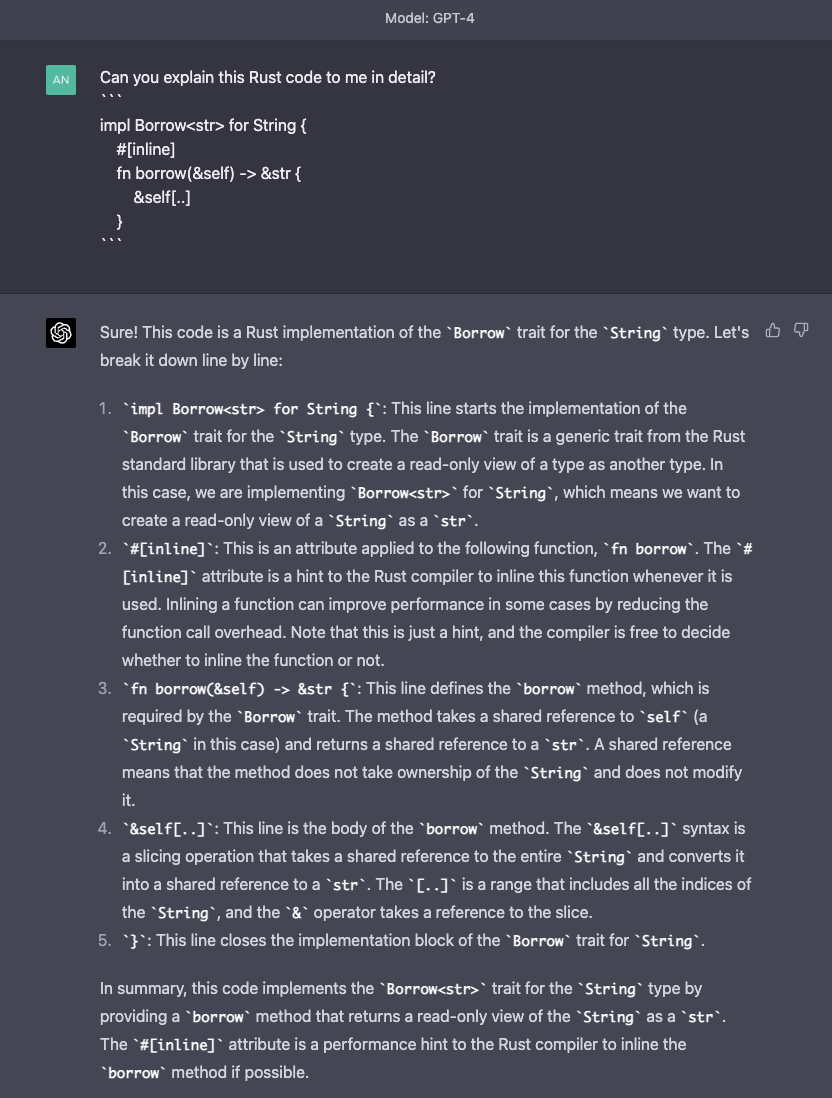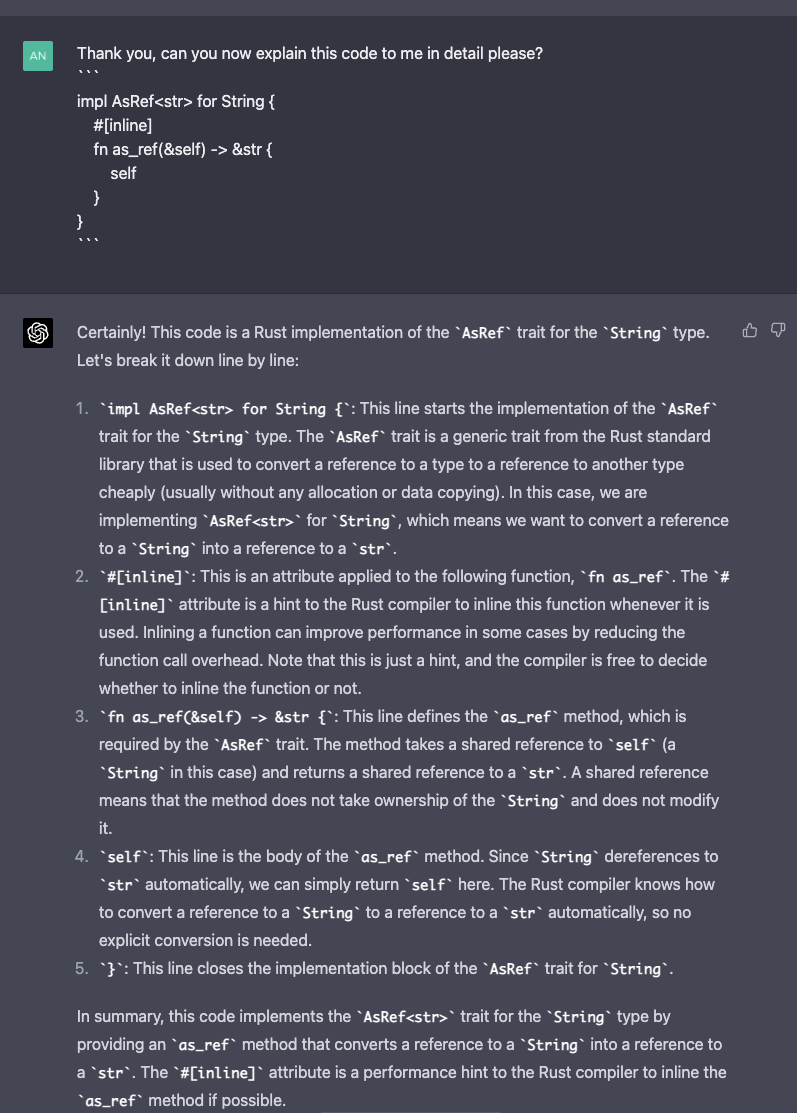AsRef vs Borrow trait (ft. ChatGPT)
This post is about my journey to grok the difference between the AsRef trait and Borrow trait (and also compare it with From and Into trait).
It started by attempting to write a simple fn that takes a two-dimensional array of char values; and ended up using ChatGPT (with GPT-4 model) to deepen my understanding of the concepts involved.
THE STORY
I was trying to write a function that takes a grid (read two-dimensional array) containing chars W (represents water) and L(represents land). The function returns the number of islands on the grid. LeetCode reference in case you're interested in the details.
So I wanted to figure out a way of writing the function so that it takes both an array and a Vec. I landed on this forum discussion where the user 'ogeon' suggests the following code that can "take anything array-ish that contains anything array-ish".
fn batch<Matrix: AsRef<[Row]>, Row: AsRef<[f32]>>(features: Matrix) {
for row in features.as_ref() {
for cell in row.as_ref() {
print!("{} ", cell);
}
println!("");
}
}
AsRef ?!?
This is great and it works(if I replaced f32 above with char), but I had no idea how this piece of code worked, mainly because I was clueless about what AsRef actually did. So I opened the docs to enlighten myself, and came across this definition.
pub trait AsRef<T>
where
T: ?Sized,
{
fn as_ref(&self) -> &T;
}
Used to do a cheap reference-to-reference conversion.
This trait is similar to
AsMutwhich is used for converting between mutable references. If you need to do a costly conversion it is better to implement From with type &T or write a custom function.
I don't know about you but as an (advanced) beginner that was not enlightening at all. So I took out the Programming Rust book to see if they had a better explanation for what AsRef is supposed to do.
And they did. Copied verbatim from Chapter 12 (2nd Edition O'Reilly):
When a type implements
AsRef<T>, that means you can borrow a&Tfrom it efficiently....
So, for example,
Vec<T>implementsAsRef<[T]>, andStringimplementsAsRef<str>. You can also borrow aString’s contents as an array of bytes, soStringimplementsAsRef<[u8]>as well.AsRefis typically used to make functions more flexible in the argument types they accept.For example, the
std::fs::File::openfunction is declared like this:
fn open<P: AsRef<Path>>(path: P) -> Result<File>What
openreally wants is a&Path, the type representing a filesystem path. But with this signature, open accepts anything it can borrow a&Pathfrom—that is, anything that implementsAsRef<Path>. Such types include String and str, the operating system interface string typesOsStringandOsStr, and of coursePathBufandPath; see the library documentation for the full list. This is what allows you to pass string literals to open:
let dot_emacs = std::fs::File::open("/home/jimb/.emacs")?;...
For callers, the effect resembles that of an overloaded function in C++, although Rust takes a different approach toward establishing which argument types are acceptable.
Armed with this knowledge, the batch() function starts to make sense:
fn batch<Matrix: AsRef<[Row]>, Row: AsRef<[f32]>>(features: Matrix) {
// -- snip --
}
So Matrix is your bog standard generic parameter with a trait bound that states that it could be any type that implements AsRef<[Row]>. And Row is another generic parameter that is bound by AsRef<[f32]> - basically any type that implements AsRef<[f32]> and therefore can return &[f32] when you call as_ref on the type. In my mental model, I started thinking of this as "function overloading" - closest thing to inheritence in Rust.
What about Borrow?
Awesome, but then I began to wonder how AsRef compares with Borrow which I (perhaps incorrectly) assumed does something similar. I opened the docs on Borrow and it says the following:
pub trait Borrow<Borrowed>
where
Borrowed: ?Sized,
{
fn borrow(&self) -> &Borrowed;
}
Trait std::borrow::BorrowA trait for borrowing data.//- snip --
These types provide access to the underlying data through references to the type of that data. They are said to be ‘borrowed as’ that type. For instance, a
Box<T>can be borrowed asTwhile aStringcan be borrowed asstr.
Huh! So when should I use Borrow vs AsRef?
I opened my trusty "Programming Rust" book again and found a slightly better explanation. Excerpt from from Chapter 12 (2nd Edition O'Reilly):
The
std::borrow::Borrowtrait is similar toAsRef: if a type implementsBorrow<T>, then its borrow method efficiently borrows a&Tfrom it. ButBorrowimposes more restrictions: a type should implementBorrow<T>only when a&Thashes and compares the same way as the value it’s borrowed from. (Rust doesn’t enforce this; it’s just the documented intent of the trait.)This makes
Borrowvaluable in dealing with keys in hash tables and trees or when dealing with values that will be hashed or compared for some other reason.This distinction matters when borrowing from
Strings, for example:StringimplementsAsRef<str>,AsRef<[u8]>, andAsRef<Path>, but those three target types will generally have different hash values. Only the&strslice is guaranteed to hash like the equivalentString, so String implements onlyBorrow<str>.
..and finally:
Borrowis designed to address a specific situation with generic hash tables and other associative collection types.
Basically, Borrow imposes additional restrictions on T so that it can be used as keys in hash tables, trees etc.
This made things slightly clearer but the docs and the stub definition leave out a very important piece of information for Borrow which I eventually found in Jon Gjengsets book - Rust for Rustacean:
Excerpt from Chapter 3:
Specifically,
Borrowis tailored for a much narrower use case: allowing the caller to supply any one of multiple essentially identical variants of the same type.It could, perhaps, have been called
Equivalentinstead. For example, for aHashSet<String>,Borrowallows the caller to supply either a&stror a&String. While the same could have been achieved withAsRef, that would not be safe withoutBorrow’s additional requirement that the target type implementsHash,Eq, andOrdexactly the same as the implementing type.
This bit 👆 is key to understand the real difference between Borrow and AsRef.
Borrow also has a blanket implementation of
Borrow<T>forT,&T, and&mut T, which makes it convenient to use in trait bounds to accept either owned or referenced values of a given type. In general,Borrowis intended only for when your type is essentially equivalent to another type, whereasDerefandAsRefare intended to be implemented more widely for anything your type can “act as.”
And what about From and Into?
If you've read so far and are now wondering - "Well, when do I implement From and Into traits because they also seem to do "conversion""? The important thing for From and Into is that they
..represent conversions that consume a value of one type and return a value of another. Whereas
AsRefandAsMuttraits borrow a reference of one type from another,FromandIntotake ownership of their argument, transform it, and then return ownership of the result back to the caller.-- Programming Rust - Blandy, Jim; Orendorff, Jason; Tindall et al
Another difference is that AsRef(and AsMut) conversions are expected to be cheap - i.e. they don't require any data copying or allocation of new memory and in most cases performed in constant time O(1), whereas From and Into conversions are not guaranteed to be cheap. It's not part of their contract.
One place where From and Into traits really shine is when we use the ? operator. You should implement them (usually the From<T> trait) for your error types.
Enter ChatGPT
I could end my post here, and honestly if you understand all of the above you can stop reading now (thanks for reading btw and make sure you buy the books linked here - I don't get any commission for referals).
I took the dog out for a walk after my "research" on this topic, and was mulling over the concepts when I decided that I had to look at the String implementation of AsRef<str> and Borrow<str> in order to solidify my understanding of Borrow and AsRef.
The implementations look like this:
// -- AsRef
impl AsRef<str> for String {
#[inline]
fn as_ref(&self) -> &str {
self
}
}
// -- Borrow
impl Borrow<str> for String {
#[inline]
fn borrow(&self) -> &str {
&self[..]
}
Now instead of trying to reason why as_ref() returns self and borrow() returns &self[..] I chose to ask ChatGPT because its 2023, and I was not disappointed by the outcome.
First the
borrowcode:Then
as_ref:Explain why?
Looks reasonable to me. So +1 for Generative AI 🤖, unless I've missed the mistake(s) in ChatGPTs explanation. Perhaps a keen-eyed reader and an experienced Rustacean can let me know.
CONCLUSION
That is all; I hope you found it as illuminating as I did. If you find any errors or mistakes, please reach out to me on twitter or via email (anup[dot]jadhav[at]gmail[dot]com). Until next time.
FOOTNOTES
This work is licensed under CC BY-NC-SA 4.0.


